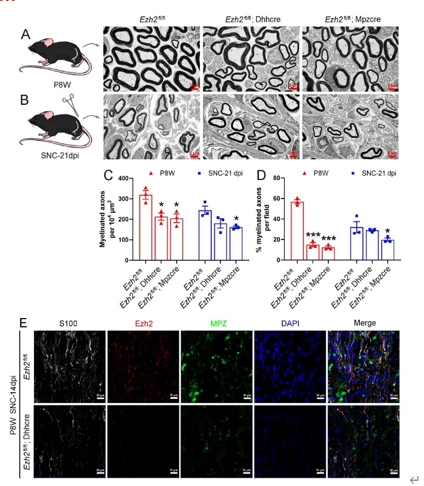中国神经再生研究(英文版) ›› 2025, Vol. 20 ›› Issue (8): 2382-2394.doi: 10.4103/NRR.NRR-D-23-02040
坐骨神经损伤后EZH2依赖性髓鞘形成
EZH2-dependent myelination following sciatic nerve injury
Hui Zhu1, #, Li Mu2, 3, #, Xi Xu1, 4, #, Tianyi Huang2 , Ying Wang2, 3, Siyuan Xu2, 3, Yiting Wang2, 3, Wencong Wang2, 3, Zhiping Wang2, 5, *, Hongkui Wang1, *, Chengbin Xue1, *
- 1 Research Center of Clinical Medicine, Affiliated Hospital of Nantong University, Key Laboratory of Neuroregeneration of Jiangsu and Ministry of Education, Coinnovation Center of Neuroregeneration, NMPA Key Laboratory for Research and Evaluation of Tissue Engineering Technology Products, Nantong University, Nantong, Jiangsu Province, China; 2 Medical School of Nantong University, Nantong, Jiangsu Province, China; 3 Department of Neurology, Affiliated Hospital of Nantong University, Nantong, Jiangsu Province, China; 4 Department of Rehabilitation Medicine, Affiliated Hospital of Nantong University, Nantong, Jiangsu Province, China; 5 Department of Critical Care Medicine, Nantong Fourth People’s Hospital, Nantong, Jiangsu Province, China
摘要:
脱髓鞘和再髓鞘化一直是研究周围神经损伤后周围神经再生的主要问题。再生髓鞘的基因调控网络不同于天然髓鞘。由于EZH2沉默可抑制体外培养的许旺细胞的分化、成熟和髓鞘形成,为研究EZH2在周围神经损伤后髓鞘形成和恢复中的作用,实验首先通过透射电镜观察2种条件性Ezh2敲除小鼠(Ezh2fl/fl;Dhh-Cre和Ezh2fl/fl;MPZ-Cre)的坐骨神经,可见2者的坐骨神经中有大量轴突保持无髓鞘状态,因此Ezh2对于正确启动许旺细胞髓鞘形成是必需的。而后对条件性Ezh2敲除小鼠建立坐骨神经夹伤模型,21d后可见大多数轴突在神经损伤部位重新聚集,且Ezh2fl/fl;MPZ-Cre小鼠的有髓神经数量明显少于野生组,即其髓鞘再生迟缓。由此得出,小鼠许旺细胞中Ezh2缺乏可导致其髓鞘形成和髓鞘再生不足,因而Ezh2是周围神经损伤后脱髓鞘和髓鞘再生过程中的关键调节因子,通过调节脱髓鞘和髓鞘再生过程中的EZH2依赖性可作为周围神经损伤新治疗靶点。
https://orcid.org/0000-0003-1378-672X (Chengbin Xue); https://orcid.org/0000-0002-8778-4682 (Hongkui Wang);
https://orcid.org/0009-0001-6712-7976 (Zhiping Wang)
